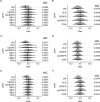Inverse Probability Weights for Quasicontinuous Ordinal Exposures With a Binary Outcome: Method Comparison and Case Study
- PMID: 37067471
- PMCID: PMC10505412
- DOI: 10.1093/aje/kwad085
Inverse Probability Weights for Quasicontinuous Ordinal Exposures With a Binary Outcome: Method Comparison and Case Study
Abstract
Inverse probability weighting (IPW), a well-established method of controlling for confounding in observational studies with binary exposures, has been extended to analyses with continuous exposures. Methods developed for continuous exposures may not apply when the exposure is quasicontinuous because of irregular exposure distributions that violate key assumptions. We used simulations and cluster-randomized clinical trial data to assess 4 approaches developed for continuous exposures-ordinary least squares (OLS), covariate balancing generalized propensity scores (CBGPS), nonparametric covariate balancing generalized propensity scores (npCBGPS), and quantile binning (QB)-and a novel method, a cumulative probability model (CPM), in quasicontinuous exposure settings. We compared IPW stability, covariate balance, bias, mean squared error, and standard error estimation across 3,000 simulations with 6 different quasicontinuous exposures, varying in skewness and granularity. In general, CBGPS and npCBGPS resulted in excellent covariate balance, and npCBGPS was the least biased but the most variable. The QB and CPM approaches had the lowest mean squared error, particularly with marginally skewed exposures. We then successfully applied the IPW approaches, together with missing-data techniques, to assess how session attendance (out of a possible 15) in a partners-based clustered intervention among pregnant couples living with human immunodeficiency virus in Mozambique (2017-2022) influenced postpartum contraceptive uptake.
Keywords: HIV; causal inference; epidemiologic methods; inverse probability weighting; nonparametric statistics; propensity score.
© The Author(s) 2023. Published by Oxford University Press on behalf of the Johns Hopkins Bloomberg School of Public Health. All rights reserved. For permissions, please e-mail: journals.permissions@oup.com.
Figures



Similar articles
-
Assessing the performance of the generalized propensity score for estimating the effect of quantitative or continuous exposures on binary outcomes.Stat Med. 2018 May 20;37(11):1874-1894. doi: 10.1002/sim.7615. Epub 2018 Mar 6. Stat Med. 2018. PMID: 29508424 Free PMC article.
-
Assessing covariate balance when using the generalized propensity score with quantitative or continuous exposures.Stat Methods Med Res. 2019 May;28(5):1365-1377. doi: 10.1177/0962280218756159. Epub 2018 Feb 8. Stat Methods Med Res. 2019. PMID: 29415624 Free PMC article.
-
Constructing inverse probability weights for continuous exposures: a comparison of methods.Epidemiology. 2014 Mar;25(2):292-9. doi: 10.1097/EDE.0000000000000053. Epidemiology. 2014. PMID: 24487212
-
Balancing vs modeling approaches to weighting in practice.Stat Med. 2020 Oct 30;39(24):3227-3254. doi: 10.1002/sim.8659. Epub 2020 Sep 3. Stat Med. 2020. PMID: 32882755 Review.
-
Causal Inference with Multilevel Data: A Comparison of Different Propensity Score Weighting Approaches.Multivariate Behav Res. 2022 Nov-Dec;57(6):916-939. doi: 10.1080/00273171.2021.1925521. Epub 2021 Jun 15. Multivariate Behav Res. 2022. PMID: 34128730 Review.
Cited by
-
Auricular Point Sticking for Patients with Sudden Sensorineural Hearing Loss: A Propensity Score Matching Analysis.Int J Gen Med. 2025 Jul 25;18:4079-4089. doi: 10.2147/IJGM.S527833. eCollection 2025. Int J Gen Med. 2025. PMID: 40735636 Free PMC article.
References
-
- Rosenbaum PR, Rubin DB. The central role of the propensity score in observational studies for causal effects. Biometrika. 1983;70(1):41–55.
-
- Robins JM, Hernán MÁ, Brumback B. Marginal structural models and causal inference in epidemiology. Epidemiology. 2000;11(5):550–560. - PubMed
-
- Naimi AI, Moodie EEM, Auger N, et al. . Constructing inverse probability weights for continuous exposures: a comparison of methods. Epidemiology. 2014;25(2):292–299. - PubMed
-
- Fong C, Hazlett C, Imai K. Covariate balancing propensity score for a continuous treatment: application to the efficacy of political advertisements. Ann Appl Stat. 2018;12(1):156–177.
-
- Hirano K, Imbens GW. The propensity score with continuous treatments. In: Gelman A, Meng X-L, eds.Applied Bayesian Modeling and Causal Inference From Incomplete-Data Perspectives. West Sussex, United Kingdom: John Wiley & Sons Ltd.; 2004:73–84.

